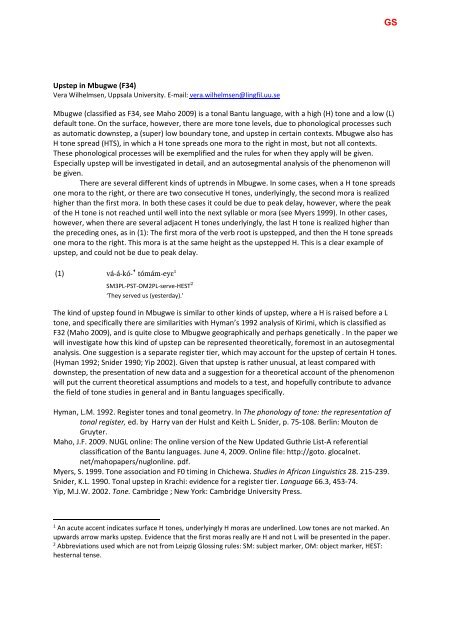here - 5th International Conference on Bantu Languages
here - 5th International Conference on Bantu Languages
here - 5th International Conference on Bantu Languages
Create successful ePaper yourself
Turn your PDF publications into a flip-book with our unique Google optimized e-Paper software.
Upstep in Mbugwe (F34)<br />
Vera Wilhelmsen, Uppsala University. E‐mail: vera.wilhelmsen@lingfil.uu.se<br />
Mbugwe (classified as F34, see Maho 2009) is a t<strong>on</strong>al <strong>Bantu</strong> language, with a high (H) t<strong>on</strong>e and a low (L)<br />
default t<strong>on</strong>e. On the surface, however, t<str<strong>on</strong>g>here</str<strong>on</strong>g> are more t<strong>on</strong>e levels, due to ph<strong>on</strong>ological processes such<br />
as automatic downstep, a (super) low boundary t<strong>on</strong>e, and upstep in certain c<strong>on</strong>texts. Mbugwe also has<br />
H t<strong>on</strong>e spread (HTS), in which a H t<strong>on</strong>e spreads <strong>on</strong>e mora to the right in most, but not all c<strong>on</strong>texts.<br />
These ph<strong>on</strong>ological processes will be exemplified and the rules for when they apply will be given.<br />
Especially upstep will be investigated in detail, and an autosegmental analysis of the phenomen<strong>on</strong> will<br />
be given.<br />
T<str<strong>on</strong>g>here</str<strong>on</strong>g> are several different kinds of uptrends in Mbugwe. In some cases, when a H t<strong>on</strong>e spreads<br />
<strong>on</strong>e mora to the right, or t<str<strong>on</strong>g>here</str<strong>on</strong>g> are two c<strong>on</strong>secutive H t<strong>on</strong>es, underlyingly, the sec<strong>on</strong>d mora is realized<br />
higher than the first mora. In both these cases it could be due to peak delay, however, w<str<strong>on</strong>g>here</str<strong>on</strong>g> the peak<br />
of the H t<strong>on</strong>e is not reached until well into the next syllable or mora (see Myers 1999). In other cases,<br />
however, when t<str<strong>on</strong>g>here</str<strong>on</strong>g> are several adjacent H t<strong>on</strong>es underlyingly, the last H t<strong>on</strong>e is realized higher than<br />
the preceding <strong>on</strong>es, as in (1): The first mora of the verb root is upstepped, and then the H t<strong>on</strong>e spreads<br />
<strong>on</strong>e mora to the right. This mora is at the same height as the upstepped H. This is a clear example of<br />
upstep, and could not be due to peak delay.<br />
(1) vá-á-kó-ꜛ tómám-eyɛ 1<br />
SM3PL‐PST‐OM2PL‐serve‐HEST 2<br />
‘They served us (yesterday).’<br />
The kind of upstep found in Mbugwe is similar to other kinds of upstep, w<str<strong>on</strong>g>here</str<strong>on</strong>g> a H is raised before a L<br />
t<strong>on</strong>e, and specifically t<str<strong>on</strong>g>here</str<strong>on</strong>g> are similarities with Hyman’s 1992 analysis of Kirimi, which is classified as<br />
F32 (Maho 2009), and is quite close to Mbugwe geographically and perhaps genetically . In the paper we<br />
will investigate how this kind of upstep can be represented theoretically, foremost in an autosegmental<br />
analysis. One suggesti<strong>on</strong> is a separate register tier, which may account for the upstep of certain H t<strong>on</strong>es.<br />
(Hyman 1992; Snider 1990; Yip 2002). Given that upstep is rather unusual, at least compared with<br />
downstep, the presentati<strong>on</strong> of new data and a suggesti<strong>on</strong> for a theoretical account of the phenomen<strong>on</strong><br />
will put the current theoretical assumpti<strong>on</strong>s and models to a test, and hopefully c<strong>on</strong>tribute to advance<br />
the field of t<strong>on</strong>e studies in general and in <strong>Bantu</strong> languages specifically.<br />
Hyman, L.M. 1992. Register t<strong>on</strong>es and t<strong>on</strong>al geometry. In The ph<strong>on</strong>ology of t<strong>on</strong>e: the representati<strong>on</strong> of<br />
t<strong>on</strong>al register, ed. by Harry van der Hulst and Keith L. Snider, p. 75‐108. Berlin: Mout<strong>on</strong> de<br />
Gruyter.<br />
Maho, J.F. 2009. NUGL <strong>on</strong>line: The <strong>on</strong>line versi<strong>on</strong> of the New Updated Guthrie List‐A referential<br />
classificati<strong>on</strong> of the <strong>Bantu</strong> languages. June 4, 2009. Online file: http://goto. glocalnet.<br />
net/mahopapers/nugl<strong>on</strong>line. pdf.<br />
Myers, S. 1999. T<strong>on</strong>e associati<strong>on</strong> and F0 timing in Chichewa. Studies in African Linguistics 28. 215‐239.<br />
Snider, K.L. 1990. T<strong>on</strong>al upstep in Krachi: evidence for a register tier. Language 66.3, 453‐74.<br />
Yip, M.J.W. 2002. T<strong>on</strong>e. Cambridge ; New York: Cambridge University Press.<br />
1 An acute accent indicates surface H t<strong>on</strong>es, underlyingly H moras are underlined. Low t<strong>on</strong>es are not marked. An<br />
upwards arrow marks upstep. Evidence that the first moras really are H and not L will be presented in the paper.<br />
2 Abbreviati<strong>on</strong>s used which are not from Leipzig Glossing rules: SM: subject marker, OM: object marker, HEST:<br />
hesternal tense.<br />
GS


